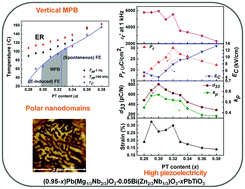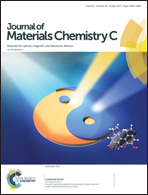Synthesis, structure and piezo-/ferroelectric properties of a novel bismuth-containing ternary complex perovskite solid solution
Abstract
To develop high-performance piezo-/ferroelectric materials and to understand their underlying physical and chemical mechanisms, a novel ternary solid solution has been synthesized by a solid state reaction method in the form of ceramics with compositions across the morphotropic phase boundary (MPB). This ternary system is formed by incorporating Bi-based complex perovskite Bi(Zn2/3Nb1/3)O3 (BZN) into the relaxor-based binary solid solution of Pb(Mg1/3Nb2/3)O3–PbTiO3 (PMN–PT). The MPB structure, relaxor-to-ferroelectric phase transformation, local polar structure, ferroelectric properties and static and bipolar piezoelectric responses were investigated. X-ray diffraction analysis indicates that the (0.95 − x)PMN–0.05BZN–xPT solid solution transforms from a rhombohedral phase to a tetragonal phase when the composition is varied across the MPB which is located at x ∼ 0.30 to 0.33. Enhanced relaxor behaviour is found in this system and the relaxor state transforms into a ferroelectric phase spontaneously upon cooling, or under application of an electric field. The incorporation of BZN into PMN–PT results in the suppression of the MPB-related depoling (at TRT) and a significant enhancement of piezoelectric and ferroelectric properties compared with those of PMN–PT binary ceramics. The optimum properties are found in the MPB composition with a static piezoelectric coefficient d33 = 805 pC N−1, an electromechanical coupling factor kp = 0.57, a remanent polarization Pr = 30 μC cm−2 and a coercive field of EC = 7.9 kV cm−1. This enhancement of properties is attributed to the beneficial effects of BZN which enhances the structural distortion due to the lone-pair electrons on Bi3+ and the ferroelectrically active Zn2+ and Nb5+, and to the enhanced relaxor behaviour arising from the increase of the local disorder and the nanodomain effect. With its strengthened properties, the (0.95 − x)PMN–0.05BZN–xPT system becomes a promising electronic ceramic material for such devices as actuators, sensors, capacitors, and transducers for a wide range of applications.



 Please wait while we load your content...
Please wait while we load your content...